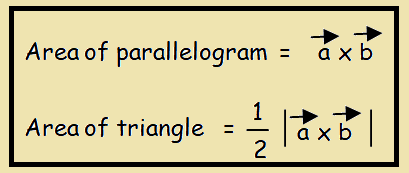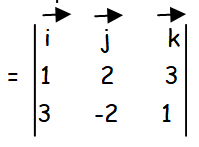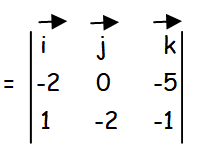FIND THE AREA OF A PARALLELOGRAM FORMED BY VECTORS
Subscribe to our ▶️ YouTube channel 🔴 for the latest videos, updates, and tips.
In this section, you will learn how to find the area of parallelogram formed by vectors.

Practice Problems
Problem 1 :
Find the area of the parallelogram whose two adjacent sides are determined by the vectors i vector + 2j vector + 3k vector and 3i vector − 2j vector + k vector.
Solution :
Let a vector = i vector + 2j vector + 3k vector
b vector = 3i vector − 2j vector + k vector.
Vector area of parallelogram = a vector x b vector

= i[2+6] - j[1-9] + k[-2-6]
= 8i + 8j - 8k
= √82 + 82 + (-8)2
= √(64+64+64)
= √192
= 8√3 square units
Problem 2 :
Find the area of the triangle whose vertices are A(3, - 1, 2), B(1, - 1, - 3) and C(4, - 3, 1).
Solution :
A vector = (3i - j + 2k) vector
B vector = (i - j - 3k) vector
C vector = (4i - 3j + k) vector
AB vector = -2i vector -5k vector
AC vector = i vector - 2j vector - k vector

= i[0-10]-j[2+5]+k[4-0]
= -10i+7j-4k
Area of triangle = (1/2) |AB vector x AC vector|
= (1/2) √(-10)2 + 72 + (-4)2
= (1/2) √(100+49+16)
= (1/2) √165
So, the area of the given triangle is (1/2) √165 square units.
Problem 3 :
If a vector, b vector, c vector are position vectors of the vertices A, B, C of a triangle ABC, show that the area of the triangle ABC is (1/2) |a × b + b × c + c × a| vector. Also deduce the condition for collinearity of the points A, B, and C.
Solution :
Let OA vector = a vector
OB vector = b vector
OC vector = c vector
Area of triangle ABC = (1/2) |AB vector x AC vector|
= (1/2) |(OB - OA) x (OC - OA)|
= (1/2) |(b - a) x (c - a)|
= (1/2) |(b x c - b x a - a x c + a x a)|
= (1/2) |(b x c + a x b + c x a + 0 vector)|
= (1/2) |a x b + b x c + c x a|
If the points A, B and C are collinear, then
Area of triangle ABC = 0
(1/2) |a x b + b x c + c x a| = 0
|a x b + b x c + c x a| = 0
a x b + b x c + c x a = 0
So, the required condition is
a x b + b x c + c x a = 0
Subscribe to our ▶️ YouTube channel 🔴 for the latest videos, updates, and tips.
Kindly mail your feedback to v4formath@gmail.com
We always appreciate your feedback.
About Us | Contact Us | Privacy Policy
©All rights reserved. onlinemath4all.com
Recent Articles
-
AP Calculus BC Problems with Solutions
Dec 20, 25 10:51 AM
AP Calculus BC Problems with Solutions -
AP Precalculus Problems and Solutions (Part - 1)
Dec 20, 25 10:49 AM
AP Precalculus Problems and Solutions (Part - 1) -
AP Calculus AB Problems with Solutions (Part - 1)
Dec 20, 25 10:49 AM
AP Calculus AB Problems with Solutions (Part - 1)
